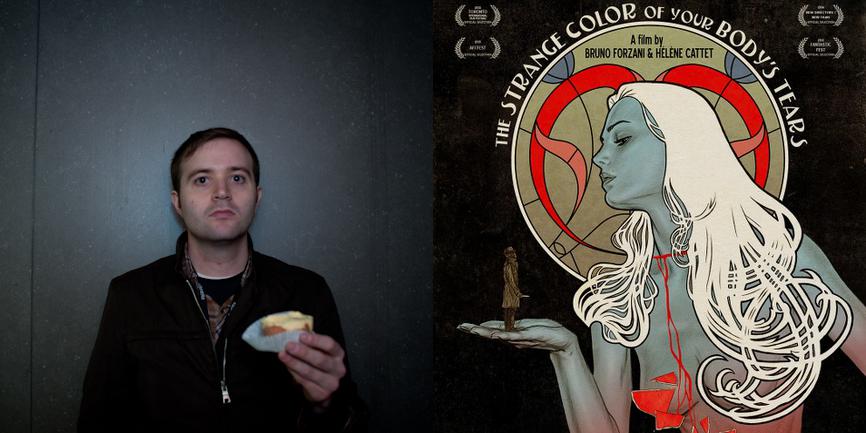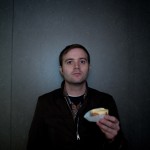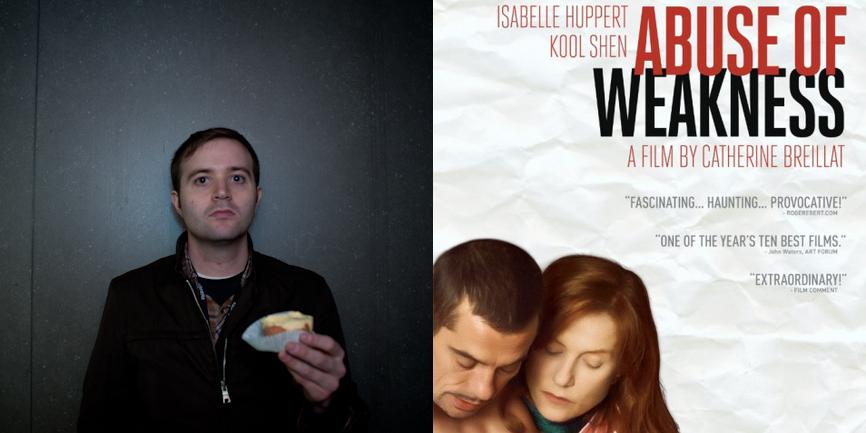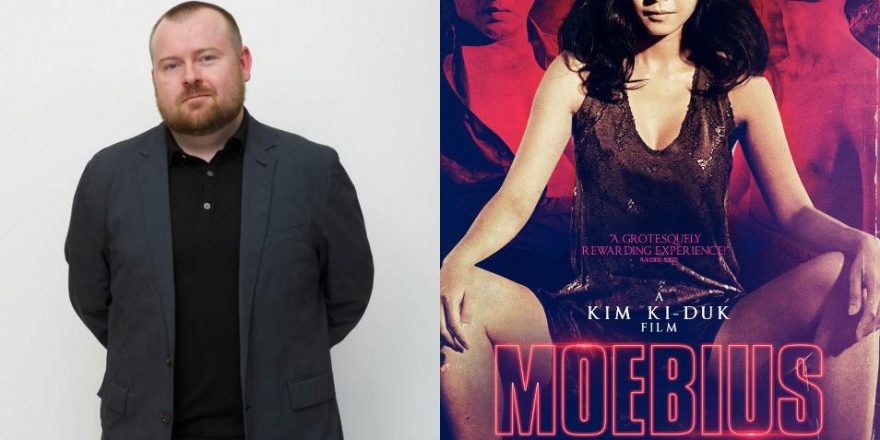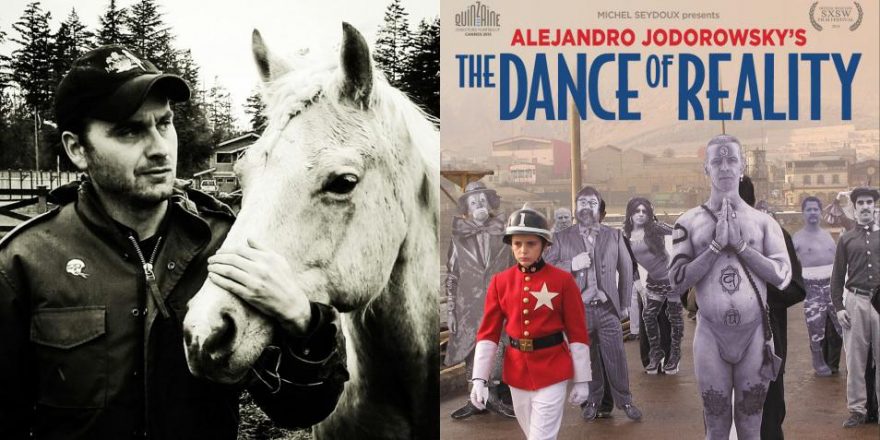I watched Terence Davies’ The Deep Blue Sea maybe three or four months ago, in the week before it expired on Netflix streaming. Never having seen one of Davies’ films before, and having heard nothing but praise from friends with great taste, I was my usual mix of excited and skeptical. I was instantly enthralled. An overpowering symphony oozed gorgeous strings over a nearly dialogue-free montage of a man and woman falling into mad, passionate love in the 1950s by way of 2011. And then (SPOILER ALERT) it was over 10 minutes later. The rest of The Deep Blue Sea is fine, maybe even great, but I’ll never be able to get over the elation I felt while thinking, “Wait, am I going to watch a 98-minute movie that is like this the entire time?” and the disappointment that came when there were just regular scenes of people talking in over-the-shoulder shots.
The Strange Color of Your Body’s Tears does what few movies even attempt — it presents an intensely stylized approach and extremely specific tone from the get-go and sticks with it 100% of the time. It’s unrelenting, uncompromising, and almost incomprehensible. What it does isn’t easy by any stretch, and whether or not it succeeds for an individual viewer will be more up to their personal wavelength than the movie achieving its actual goals. I loved it. I watched it on a link in my living room and was constantly wishing I was in a theater, with the biggest screen imaginable and the 5.1 cranked to 11.
I’ll avoid a plot synopsis. Instead I’ll offer this, which is what the movie actually feels like while you’re watching it:
MOUTH FACE EYES LOOK FOOTSTEPS SKIN HANDS
SHADOWS WINDOWS WALLPAPER
LACE NIPPLE LEATHER KNIFE
PINK BLUE RED STAINED GLASS STATIC MUSIC SILENCE
BREATHING SEX MURDER BLACK & WHITE EYEBALL
STAB SLICE BLEED GUSH CREAK
CHILD BOX VORTEX KALEIDOSCOPE
HAIR GLOVES GORE DOUBLES
DOORWAY
DOORWAY
DOORWAY
DOORWAY
Hélène Cattet and Bruno Forzani’s less coherent, more cohesive follow-up to 2009’s Amer, the film plays like a 100-minute supercut of all things giallo — the Italian slasher sub-genre defined by black-gloved murderers and ample doses of eroticism. Except this isn’t a viral Vimeo mashup of Dario Argento, Mario Bava, Lucio Fulci, Umberto Lenzi, etc., but a meticulously crafted recreation and re-imagination of their collective style kicked into overdrive. Unlike Cattet and Forzani’s previous film, whose stylish terrors escalated effectively but much more traditionally (its first act is a mini-masterpiece), Strange Color doesn’t just fetishize the aesthetics of European genre cinema, it fetishizes literally everything. There isn’t a touch, a breath, a look, a whatever that isn’t deconstructed and reconstructed through Cattet and Forzani’s non-stop extreme close-ups and masterful, maddeningly specific sound design.
“My vice is nothing other than my pleasure.”
That line of dialogue, repeated twice in the film, sums up Strange Color with perfect clarity. It exists so solely for its own indulgences that it’s constantly in danger of derailing itself. If you’re not with it in the first five to 10 minutes, you never will be. If you are with it, then holy shit, are you going to be with it. It has the pacing of a music video even when there’s no music. It has the energy of a commercial, but without a product. While Amer could be described as an art house horror movie, Strange Color is an art house movie about horror movies. Tension and release are all but negated, likewise story and character. It’s a tactile, sensory overload that only really starts to slip in the last 10 to 15 minutes, when it feels like it has to provide some vague answers to its myriad mysteries.
It’s impossible to watch this movie without thinking about the films it’s referencing, wallowing in. Dario Argento’s oeuvre is the obvious go-to, and the baroque, psychedelic architecture of Suspira and Inferno looms constantly over the production design. The sound design evokes the live-action films of Jan Švankmajer, especially his ode to masturbation, Conspirators of Pleasure. I thought frequently of Brian DePalma, possibly because I’ve been on a DePalma bender lately, but also because he’s the American filmmaker who most closely compares to Argento. Like Argento, DePalma’s cinema is one of aesthetics. His plots operate for the sake of their own circuitousness. His camera is constantly innovating, discovering, fetishizing. The style is the substance (and it’s by this definition that I vehemently believe Femme Fatale to be as much a masterpiece as Dressed to Kill, Blow Out, and Body Double). DePalma’s vices are also his pleasures. As are Argento’s. And Svankmajer’s.
More than any other sub-genre of independent/art-house film, horror has a nostalgia fetish that it can’t seem to kick. Every great horror film of the last decade or so is deeply indebted to those of bygone decades. Rob Zombie’s first two features get at the themes and aesthetics of The Texas Chain Saw Massacre from opposite angles. Ti West’s The House of the Devil was a loving homage to the muted palette of ‘80s video store horrors and their slowburn nihilism (to underscore this, it was released on VHS two decades after the format died). Franck Khalfoun’s Maniac remake re-imagined the essential 1980 slash-and-sleaze fest literally from the inside out. It’s happening in Hollywood, too — with James Wan’s The Conjuring being the obvious example. Cattet and Forzani’s closest cousin this side of the Atlantic may be Calvin Lee Reeder, whose films — especially The Oregonian — turn the look of grainy, gory drive-in shockers into Lynchian freak-outs that eschew logic to put the audience in a state of non-stop WTF.
But why do all these filmmakers so consistentlylook backwards for inspiration? Have horror movies really not been any good in the last 30 years? Has the internet/cell phone takeover broken down isolation barriers that these films can’t effectively work around yet? Are today’s auteurs de terreur simply looking to the movies of their childhood, when the manufactured danger felt new and real? Is it even possible to not be postmodern anymore? If the only horror movies I enjoy are so steeped in the tropes of the past, am I just another victim of nostalgia? The answer to most of those questions is probably “yes,” but I don’t think that detracts from the merits of anything I’ve mentioned. There’s a stylistic freedom granted by genre film and it’s exciting to see directors run with it. (Though I’ve never made one myself, so I could be romanticizing.) What separates Strange Color and these other films from their peers is that they don’t just coldly mimic what’s been done before, they experiment and expand upon the work of their predecessors. Cattet and Forzani’s sinister confection is yesterday’s style for today’s attention span, and that’s not a knock, that’s what’s smart and enjoyable about it.
“My vice is nothing other than my pleasure.”
Now that I think about it, that line is really the mission statement of all genre film — what makes them deplorable is also what makes them fun, and potentially great. Every movie should have something that’s deplorable to someone, right?



